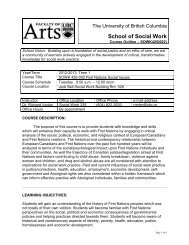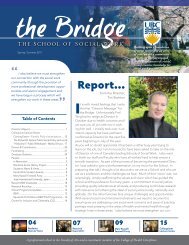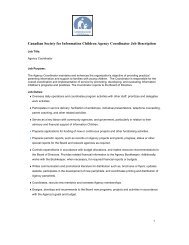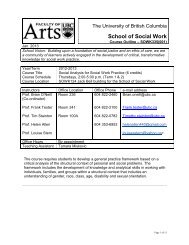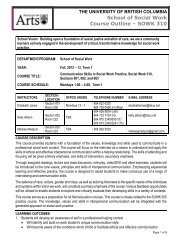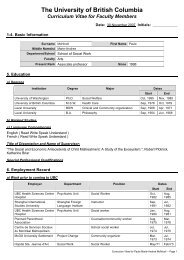Equity Case Studies Report - School of Social Work - University of ...
Equity Case Studies Report - School of Social Work - University of ...
Equity Case Studies Report - School of Social Work - University of ...
Create successful ePaper yourself
Turn your PDF publications into a flip-book with our unique Google optimized e-Paper software.
UBC school <strong>of</strong> social work equity and diversity strategic plan: A compilation <strong>of</strong> case studies 105<br />
Best Practices for Faculty Selection<br />
According to the <strong>University</strong> <strong>of</strong> California Affirmative Action Guidelines for Faculty<br />
Recruitment and Retention,<br />
The Federal affirmative action regulations provide the <strong>University</strong> with great flexibility in<br />
developing action-oriented programs and demonstrating good faith efforts to provide<br />
equal employment opportunity in faculty hiring. However, Proposition 209 does not<br />
permit the <strong>University</strong> to grant preferences on the basis <strong>of</strong> race or gender in the selection<br />
process for academic appointments. Therefore, programs that allowed departments to<br />
consider affirmative action in hiring decisions such as the Target <strong>of</strong> Opportunity for<br />
Diversity and the “tie-breaker” policy are no longer available as tools to increase<br />
academic employment opportunities for women and minorities. However, there are still<br />
important steps that departments can take that will serve to ensure that faculty selection<br />
practices provide equal opportunity for all candidates and do not inadvertently create<br />
barriers or biases in the selection. (<strong>University</strong> <strong>of</strong> California, 2002)<br />
The Affirmative Action Guidelines promotes best practices for faculty selection by<br />
analyzing the pool by reviewing the applicants prior to beginning the selection process to<br />
determine if women and minority applicants are represented in the pool. If women and minority<br />
applicants are not present in the pool at about the rate <strong>of</strong> their estimated availability in the field,<br />
then departments should review whether recruitment and outreach procedures were sufficiently<br />
broad, and if not, consider reopening the search with expanded inclusive recruitment efforts<br />
(<strong>University</strong> <strong>of</strong> California, 2002).<br />
Best Practices for Faculty Retention<br />
The UC Affirmative Action Guidelines encourages campuses to be attentive to any<br />
retention problems that may negatively affect faculty diversity and equal employment<br />
opportunity (<strong>University</strong> <strong>of</strong> California, 2002). In addition, federal affirmative action regulations<br />
require UC campuses to collect data on race and gender on promotions, transfers, and<br />
resignations to ensure that efforts are made to address any racial or gender-based inequities that<br />
may be indicated in the data (<strong>University</strong> <strong>of</strong> California, 2002). Other tools to address any equity<br />
issues connected to faculty retention include:<br />
1. Exit interviews.<br />
2. Mentoring junior faculty with formal mentoring programs and workshops to assist in the<br />
tenure process.<br />
3. Faculty development programs that provide financial support and/or release time to<br />
support research and assist junior faculty in their progress toward tenure, reward faculty<br />
who are engaged in research focused on issues such as race, ethnicity, gender, and<br />
multiculturalism, and allocate resources to faculty who have demonstrated a commitment<br />
to issues <strong>of</strong> social, education, and economic justice through their teaching and service.<br />
4. Accommodating special needs. For example, implementing policies concerning leave<br />
and modified duties to accommodate faculty with parenting, medical, and disabilityrelated<br />
needs. Other examples include childcare resources and facilities being available<br />
to faculty.<br />
5. Monitoring pay equity through conducting periodic summary level salary reviews to<br />
ensure that disparities in pay on the basis <strong>of</strong> race or gender do not exist. If problem areas<br />
are found, campuses are strongly encouraged to investigate individual cases. (<strong>University</strong><br />
<strong>of</strong> California, 2002)



